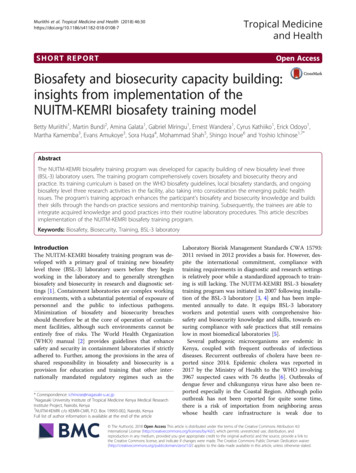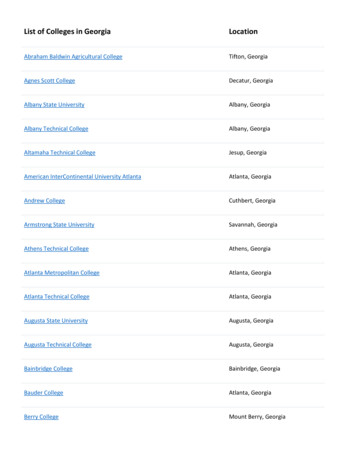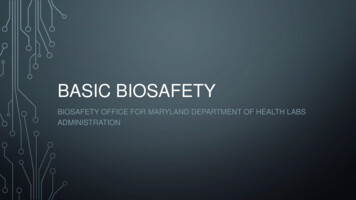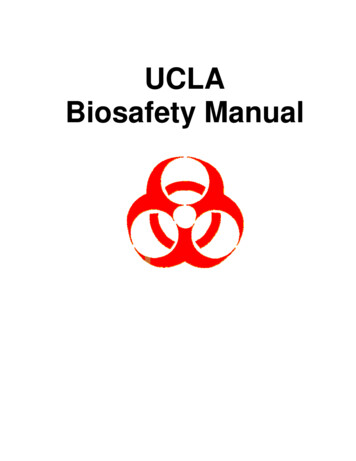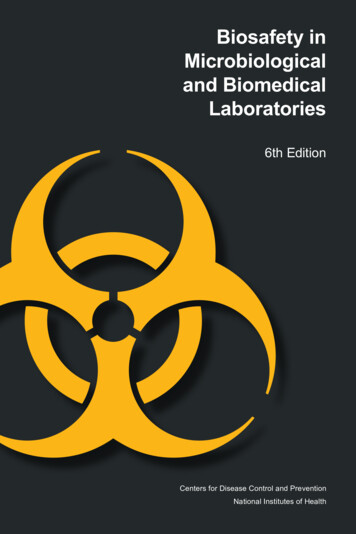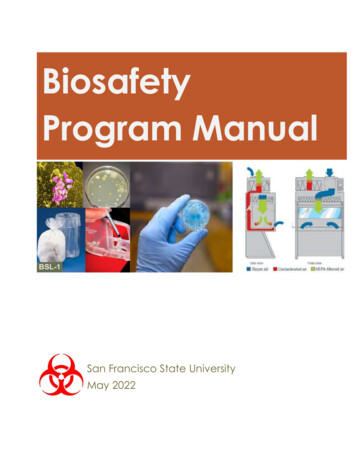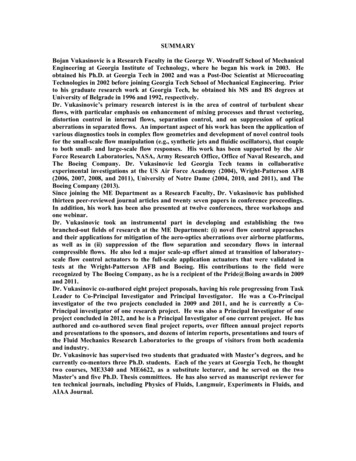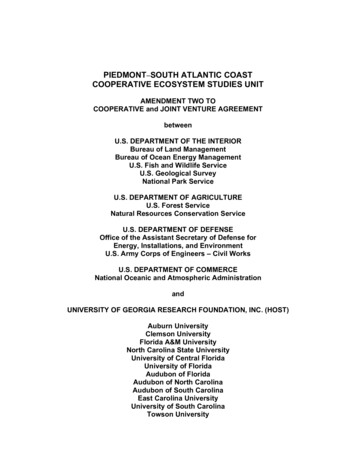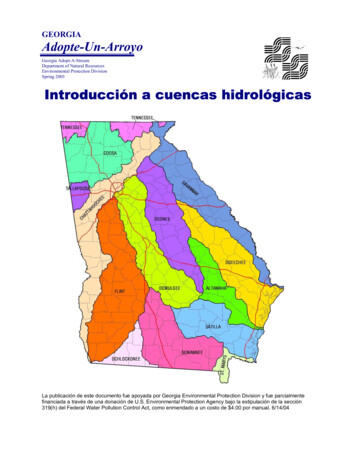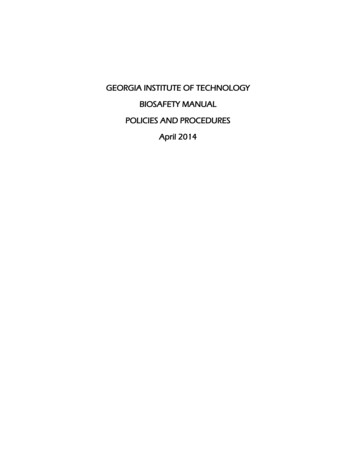
Transcription
GEORGIA INSTITUTE OF TECHNOLOGYBIOSAFETY MANUALPOLICIES AND PROCEDURESApril 2014
TABLE OF CONTENTSSignature Page for Laboratory PersonnelPurposeEnvironmental Health and SafetyBiological Materials Safeguards CommitteeInstitutional Biosafety CommitteeOccupational Health and Safety CommitteeSection I --- ResponsibilitiesSection II --- Institute Response to Unsafe Actions and/or Unsafe Conditions inLabsSection III --- Personal Protective EquipmentSection IV --- Biological Materials DefinitionsSection V --- Biosafety Level DefeintionsSection VI --- Containment of Biohazardous ResearchSection VII --- Application Procedures for ResearchSection VIII --- Biosafety Laboratory InspectionsSection IV --- Recombinant and Synthetic Nucleic Acid ResearchSection X --- Cell Line and Primary Cell ResearchSection XI —Viral Vector PolicySection XII — Select Agent ProgramSection XIII --- Dual Use ResearchSection XIV --- BiosecuritySection XV --- Biosafety TrainingsSection XVI --- Biological Waste HandlingSection XVII --- Handling and Disposing of SharpsSection XVIII — Handling Spills of Biological MaterialsSection XIX— Guidelines for Moving Biological Materials Around CampusSection XX --- Shipment of Biological MaterialsSection XXI --- Workplace Occupational Health PolicySection XXII --- Occupational Health ProgramSection XXIII--- Laboratory EquipmentSection XXIV --- Autoclave GuidelinesSection XXV --- Biosafety Cabinet GuidelinesSection XXVI --- Guidelines for Moving Laboratory EquipmentSection XXVII --- HandwashingSection XXVIII --- Bloodborne PathogensSection XXIX --- First Aid in the LaboratorySection XXX --- Links to Further ResourcesAppendix A- Example of a Biohazard SignAppendix B- Georgia Tech Emergency ProceduresAppendix D- Integrated Pest ManagementForms 1 - BMSC FormsBiosafety Manual 3Revision Date: 21-Apr-14Page 2 of 155
Forms 2 - IBC FormsForms 3 - Occupational Health Program FormsForms 4 - Select Agent FormsForms 5 - Laboratory Inspection FormsForms 6 - Biological Shipment FormForms 7 - Material Transfer Agreement FormsBiosafety Manual 3Revision Date: 21-Apr-14Page 3 of 155
Signature Page for Laboratory PersonnelI certify that: I have received, in the laboratory, safety training on thebiological materials listed below. I have read and understand the Georgia Tech BiosafetyManual, and will abide by the policies set forth in thatdocument.Biological Materials I am trained to work with:SignatureDateBiosafety Manual 3Revision Date: 21-Apr-14Page 4 of 155
PURPOSEThis document provides informational and policy resources for all Biosafety Level1 (BSL-1) and Biosafety Level 2 (BSL-2) laboratory facilities and classrooms locatedat Georgia Institute of Technology and areas located off-campus under thesupervision of Principal Investigators associated with Georgia Institute ofTechnology. Specifically, it details the approval process of all biological activitiesand details the standard operating procedures to be used to ensure a safeworking environment while conducting research with recombinant DNAmaterials, toxins, infectious microorganisms, human cell cultures, body fluids, andother biological materials. The manual also addresses the movement ofequipment and materials on and off campus to ensure the safety of those outsideof Georgia Tech laboratories. This manual will be reviewed annually by theBiosafety Officer for changes or corrections to ensure that it is timely andaccurate.Biosafety Manual 3Revision Date: 21-Apr-14Page 5 of 155
ENVIRONMENTAL HEALTH & SAFETYThe Environmental Health & Safety (EHS) office is responsible for biosafety onGeorgia Tech’s campus. EHS also provides guidance and oversight forlaboratory safety programs including biosafety, chemical safety, laser, andradiological safety, provides fire safety and general safety services, processes andmanages hazardous materials for proper disposal, provides emergency responsefor hazardous materials incidents / accidents (spills), and provides safety training.For EHS Contacts, please check the EHS website: www.ehs.gatech.eduBiosafety Manual 3Revision Date: 21-Apr-14Page 6 of 155
Members of the Biological Materials Safeguards CommitteeGeorgia Institute of TechnologyChair: Alfred Merrill, Ph.D.Professor and Smithhgall Chair inMolecular Cell BiologySchool of Biology404 / 385-2842Thomas Barker Ph.D.Associate ProfessorDepartment of BiomedicalEngineeringJim Spain, Ph.D.ProfessorSchool of Civil andEnvironmental EngineeringMary BeranCompliance Officer,Office of Research Compliance404 / 385-5044404 / 894-0628Mark DemyanekEnvironmental Health and SafetyAssistant Vice PresidentMeagan FitzpatrickBiosafety Officer andResponsible OfficialEnvironmental Health andSafetyShane GilloolyAssistant Biosafety Officer andResponsible OfficialEnvironmental health andSafety404 / 894-1244404 / 894-6120404 / 894-6119404 / 385-2083The Biological Materials Safeguards Committee (BMSC) has the important missionof reviewing all applications for research, teaching, and training that involve theuse of select agents, pathogenic organisms other than select agents, etiologicalagents, certain human samples, and other biological materials at Georgia Techand ensuring that the proposed activities comply with the federal regulationsgoverning them. The BMSC works closely with Georgia Tech’s InstitutionalBiosafety Committee (IBC), the Institute Animal Care and Use Committee (IACUC),the Office of Research Integrity Assurance (ORIA), and the EHS Biosafety Officer.The BMSC holds meetings as needed to review applications proposing the use ofbiological materials including pathogenic organisms, select agents, etiologicalagents, and human samples.Biosafety Manual 3Revision Date: 21-Apr-14Page 7 of 155
Members of the Institutional Biosafety CommitteeGeorgia Institute of TechnologyChair: Andres Garcia, Ph.D.Associate ProfessorSchool of Mechanical EngineeringVoice 404-385-9384Fax 404/894-0519Kirill Lobachev Ph.D.Associate ProfessorSchool of BiologyMeagan FitzpatrickBiosafety OfficerEnvironmental Health &SafetyTodd McDevitt, Ph.D.Associate ProfessorSchool of MechanicalEngineering404 / 894-6120404/ 385-6647Robert J. FintonCommunity MemberJeffrey D. OwensCommunity Member404 / 385-6197Deborah Ann Cook, Ph.D.Community MemberEx Officio:Pamela RarySenior AttorneyOffice of Legal AffairsJilda D. Garton, M.S.AVP for Research & General Manager, GTRCGeorgia Institute of Technology404/ 894-4812404 / 894-4819Office of Research Integrity AssuranceRhonda MillerResearch AssociateOffice of Research Integrity AssuranceMary BeranAssociate DirectorOffice of Research Integrity Assurance404/385-0288404 / 385-2083Barbara S. HenryExecutive Director,Office of Research Integrity Assurance404 / 894-6949The Institutional Biosafety Committee (IBC) has the important mission ofreviewing all applications for research, teaching, and training that involve the useBiosafety Manual 3Revision Date: 21-Apr-14Page 8 of 155
of recombinant DNA and ensuring that the proposed activities comply with thefederal regulations governing them. The IBC is responsible for maintainingGeorgia Tech’s registration with the National Institutes of Health’s Office ofBiotechnology Activities (OBA). IBC works closely with the EHS Biosafety Officer.The IBC holds meetings on a quarterly basis or as needed to review applicationsproposing use of recombinant DNA.General guidelines for covered rDNA projects can be found lines.htmlBiosafety Manual 3Revision Date: 21-Apr-14Page 9 of 155
Members of the Occupational Health CommitteeGeorgia Institute of TechnologyChair: Dennis Folds, Ph.D.Principal Research ScientistGRTI-ELSYS404/407-7262Dr. Laura O’FarrellAttending VeterinarianGTRCScott MorrisonChief HR OfficerHuman ResourcesDirector of FacilitiesOperations and bara S. HenryExecutive DirectorOffice of ResearchIntegrity AssuranceMeagan FitzpatrickBiosafety OfficerEnvironmental Health &SafetyShane GilloolyAssistant Biosafety OfficerEnvironmental Health andSafety404 / 894-6949404 / 894-6120404/894/6119Debbie Wolfe-LopezChemical Safety ManagerOffice of EnvironmentalHealth and SafetyAleece FoxxGeneral Safety ManagerOffice of EnvironmentalHealth and SafetyMarueen OlsenMedical Director of StudentHealth Services404/385-2964404/385-0263404/385-3256Ex OfficioMark DemyanekAssistant Vice PresidentEnvironmental Health and Safety/Facilities Management404 / 894-1244The Occupational Health and Safety Committee (OHSC) has the mission ofensuring employee and student workplace health and safety. The committee isresponsible for developing and advising EHS on the administration of theOccupational Health Program for workers engaged in research using animalmodels, human tissues and blood, pathogenic organisms, select agents, andother biological materials. OHSC works closely with Georgia Tech’s ResponsibleOfficial and Biosafety Officer in the Office of Environmental Health and Safety.Biosafety Manual 3Revision Date: 21-Apr-14Page 10 of 155
SECTION I- RESPONSIBILITIESA.Georgia Institute of TechnologyThe Institute and its administrative officers are responsible for the following:1) Endorsing appropriate policies, including this manual, regarding theconduct of potentially biohazardous research, education, and serviceactivities.2) Developing mechanisms for ensuring faculty and staff adherence tobiosafety policies.3) Providing the resources necessary for the construction of safe researchand teaching facilities.4) Provide the resources for the implementation of a comprehensivebiosafety program.5) Providing adequate resources for the dissemination of information onbiohazards and biosafety procedures, including training programs andworkshops.6) Providing resources for appropriate medical surveillance measures toprotect the health and safety of employees.B.Biosafety Officer/Assistant Biosafety OfficerThe Institute’s Biosafety Officer has responsibility for the daily administration ofbiosafety standards set by the BMSC, IBC, and OHSC. Other responsibilitiesinclude:1) Review grant applications and determine if the research is properlyapproved by the Biological Materials Safeguards Committee as well as toensure that the laboratory is in compliance with all biosafety policies.2) May suspend or interrupt any experiment if there is an immediate threat tohuman health and safety from the experiment or other conditions in thelaboratory by following the procedure described in Section II of thismanual.3) Review BMSC applications and assign applications to the BMSC for reviewas appropriate.4) Arranging for initial and periodic inspections of laboratories used inbiohazardous research to ensure that standards set by the BMSC, IBC, andOHSC are followed.Biosafety Manual 3Revision Date: 21-Apr-14Page 11 of 155
5) Providing technical advice to Principal Investigators and to the BMSC, IBC,and OHSC committees on research safety procedures.6) Develop and conducting trainings on biological materials for the Institutecommunity.7) Providing technical advice to the Institute regarding biohazard safetyneeds and requirements for projects involving the renovation orconstruction of laboratory or other facilities in which biohazards will beused.8) Participate in committee meetings involving biological safety.C. Responsible Official/Alternate Responsible Official for Select AgentsThe Responsible Official has the following responsibilities:1) Submits applications regarding select agents to United States Departmentfor Health and Human Services via the Center for Disease Control (CDC) orUnited States Department of Agriculture via the Animal Plant HealthInspection Services (APHIS) for Georgia Tech.2) Works with Emergency Preparedness to determine security needs forselect agent or toxin laboratories.3) Develop a biosafety plan for select agent laboratories.4) Regularly inspect laboratories containing select agents.5) Develop an emergency response plan for laboratories housing selectagents.6) Provide training for all individuals that work with the select agent/toxin.7) Keep thorough records of individuals, inventories, and areas whereagents/toxins are used.8) Provide technical advice to the BMSC on select agent proposals.9) Notify DHHS to report thefts, losses, or releases of select agent/toxin.10) Advise PI on destruction of materials and notify DHHS before destroying aselect agent/toxin.D.Biological Materials Safeguards CommitteeBiosafety Manual 3Revision Date: 21-Apr-14Page 12 of 155
The Biological Materials Safeguards Committee (BMSC) serves to advise theInstitute’s administration on policies pertaining to biological research. Thecommittee recommends standards under which biohazardous activities shouldbe conducted and reviews projects for compliance with appropriate federal,state, and Institutional guidelines and regulations. Other specific responsibilitiesinclude:1) Review for appropriateness and adequacy the containment levels andsafety measures proposed and/or used in biohazardous research andteaching.2) Assess the adequacy of containment facilities for biohazards of selectagents, pathogens, etiological agents, certain human samples, and otherbiological materials as required by regulatory agencies.3) Develop, with the Biosafety Officer, training seminars and workshops onbiohazards for the Institute community.4) Periodically review biological research being conducted at the Institute toinsure that the requirements of the Institute, funding sources, andregulatory agencies are being fulfilled.5) Recommend to the Institute Administration appropriate sanctions for noncompliance with biosafety standards, guidelines, or regulations.6) Develop with the Biosafety Officer emergency plans covering accidentalspills and personnel contamination resulting from biohazardous research.The chairman of the committee is selected by the Provost and the Executive VicePresident for Administration and Finance. The chairman then selects committeemembers from Institute professors with bacterial, viral, and cell line expertise. TheBiosafety Officer, Assistant Biosafety Officer and Assistant Vice President of EHSalso serve on the committee for regulatory expertise for biosafety and selectagents.E.Institute Biosafety CommitteeThe Institutional Biosafety Committee (IBC) strives to ensure the safe conduct ofactivities involving recombinant DNA (rDNA). The committee also advises theInstitute’s administration on policies pertaining to rDNA research. The committeeestablishes standards under which rDNA activities should be conducted andreviews projects for compliance with appropriate federal, state, and Institutionalguidelines and regulations. Other specific responsibilities include:1) Review for appropriateness and adequacy the containment levels andsafety measures proposed and/or used in rDNA research and teaching.Biosafety Manual 3Revision Date: 21-Apr-14Page 13 of 155
2) Assess the adequacy of containment facilities for rDNA molecules asrequired by NIH or other funding or regulatory agencies.3) Periodically review rDNA research being conducted at the Institute toinsure that the requirements of the Institute, funding sources, andregulatory agencies are being fulfilled.4) Reviews allegations of non-compliance with rDNA standards, guidelines,or regulations.5) Develop, with the Biosafety Officer, emergency plans covering accidentalspills and personnel contamination resulting from rDNA research.The minimum composition of the Institutional Biosafety Committee (IBC) isspecified in the NIH “Guidelines for Research Involving Recombinant DNAMolecules”. The IBC shall have at least 5 members selected to have expertise andexperience in recombinant DNA technology and capable of assessing the safetyof rDNA research experiments and any potential risks to public health and theenvironment. The IBC shall include at least 2 members who are not affiliated withthe Institute by other than their committee membership. In addition, whenexperiments using mammals or plants require prior IBC approval, there shall be atleast one (1) scientist with expertise in plant pathogens or plant pest containmentand one (1) scientist with mammalian containment expertise on the IBC. Themembers of the IBC are appointed by the Vice Provost of Research andInnovationF.Occupational Health and Safety CommitteeThe Occupational Health and Safety committee serves to advise the Institute’sadministration on policies pertaining to the creation and maintenance of asafe research environment. Other specific responsibilities include:1) Advises EHS on the development and administration of anOccupational Health Program (OHP).2) Periodically reviews the OHP for effectiveness and compliance withsafety regulations.3) Reviews and develops other Institute occupational health policiesfor implementation of best management practices.4) Reviews Institute incidents for areas of improvement to policy.The committee is composed of members with expertise in occupational health,faculty, EHS staff members, healthcare professionals, and research compliance.The committee is appointed by the Executive Vice President of Business andFinance and the Provost.Biosafety Manual 3Revision Date: 21-Apr-14Page 14 of 155
G.Department/Unit HeadsDepartment/Unit Heads have the following responsibilities:1) To ensure that, prior to initiation of work, each investigator or laboratorydirector using a biological agent files the appropriate committeeapplications and receives approval prior to initiation of research activitieson campus.2) To ensure that staff and students have had instruction in safety proceduresin teaching laboratories or field situations where biohazardous agents areused.3) To ensure that appropriate facilities and safety equipment are available forproposed research or instruction involving biohazardous agents.4) To ensure that all faculty, staff, and students are following EHS policies,guidelines, and enrolls in the appropriate EHS programs.5) To provide leadership in laboratory safety at the management level in thedepartment.H.Faculty and Professional Staff (Principal Investigators/Project Directors)Developing and maintaining a healthy and safe work environment depends onthe day-to-day supervision of research practices by personnel with a positivesafety attitude. The principal investigator (PI), laboratory director, project director,or teaching supervisor is responsible for knowing and complying fully withGeorgia Institute of Technology Biosafety Manual and the General LaboratorySafety Manual. The principal investigator and/or laboratory supervisor shall:1) Provide those personnel under his/her supervision with knowledge ofbiological materials to which they may be exposed and safety proceduresto be followed. This is to be accomplished by:a. The PI being knowledgeable of good laboratory safetypractice and a positive safety attitude.b. Posting or making readily available to the laboratory staffcopies of the protocols that describe potentialbiohazards/rDNA issues and the precautions to be taken.These protocols, as well as biosafety concerns, should first bein the form of a well written proposal application and thentranslated into standard operating procures for each task inthe laboratory.c. Providing laboratory staff with formal and informalinstruction and training in the practices and techniquesBiosafety Manual 3Revision Date: 21-Apr-14Page 15 of 155
required to ensure safety. This should include procedures fordealing with accidental spills, personnel contamination, andother laboratory accidents.d. Supervising the performance of the staff to ensure thatrequired safety practices and techniques are employed.2) Report, via an EHS Injury and Illness Report Form, any accident, exposure,or suspected illness of laboratory personnel.3) Report in writing to the Biosafety Officer any release from containment ofbiohazardous/rDNA agents or significant problems pertaining tooperations and implementation of containment practices and procedures.4) Ensure that all laboratory members under their direction are following allEHS polices and guidelines as well as participate in the appropriate EHStrainings.5) Adhere to the IBC and BMSC approved emergency plan for handling spillsand personnel containment.6) Insure the integrity of the physical containment of the laboratory.7) Notifying EHS prior to buying a BSC, so that the appropriate equipment isselected as well as notifying EHS once the BSC has been installed to allowfor certification. PI’s are also required to have all cabinets decontaminatedprior to movement from one area to another. This must also be brought toEHS attention for coordination of decontamination and recertification inthe new location.8) Adhere to the requirements of federal and state agencies, DOT, FAA, andGeorgia Tech for interstate and international shipment of biological agentsand rDNA.9) The Principal Investigator is responsible for keeping the laboratory securefrom unauthorized persons by developing laboratory security policies. Forresearch areas requiring high security, the PI/PD should seek assistancefrom the Director of Emergency Preparedness at 404-894-8392.10) The Principal Investigator is responsible for appointing a designee to actas substitute PI if at any point he/she will be away from campus for morethan 90 days or is he/she leaves an operating laboratory when leavingGeorgia Tech permanently.I.Research Staff and StudentsBiosafety Manual 3Revision Date: 21-Apr-14Page 16 of 155
Research Staff and Students are the day-to-day practitioners of biosafety. Eachmember of a laboratory should be well versed in general biosafety as well asspecific Georgia Tech Biosafety requirements. Research staff and students shall:1) Read and understand the information contained in the Georgia TechBiosafety Manual.2) Complete a Signature page for Laboratory Personnel and return the formto EHS.3) Enroll in the Occupational Health Program by completing theOccupational Health Program Confidential Risk Assessment/ExposureQuestionnaire.4) Attend EHS training based on research activities and as determined byyour personal risk assessment/exposure questionnaire.5) Follow all safety and security guidelines established by EHS via theGeorgia Tech Biosafety Manual, the Georgia Tech Laboratory SafetyManual and your PI.6) Report all accidents and spills immediately to the PI and EHS or GeorgiaTech Police if after hours.Biosafety Manual 3Revision Date: 21-Apr-14Page 17 of 155
SECTION II – INSTITUTE RESPONSE TO UNSAFE ACTIONS AND/ORUNSAFE CONDITIONS IN LABORATORIESTaken from the Georgia Tech Laboratory Safety Manual (May, 2013) pages 15-18The following table provides guidance as to how laboratory hazard levels areidentified and responded to by EHS. However, this list is not all inclusive;individual circumstances will vary, and the most appropriate action will be taken:Level 1: Imminent Hazard with Potentially Severe ConsequencesImminent hazard caused by unsafe conditions or unsafe actions which, in thejudgment of the EHS representative on site, have the potential for severeconsequences, and may result in: Loss of life Serious injury with possibility of permanent damage to health orpermanent disability Injury (including those by chemical exposures) likely to result inhospitalization May affect people outside of the lab May involve multiple victims May involve significant property damage, and/or building-wide businessdisruption and/or business disruption affecting the Institute.Examples of imminent hazards with potentially severe consequences that mayresult from unsafe conditions or unsafe acts include but are not limited to: Fires Floods Toxic or flammable gas releases or explosions Releases of highly toxic materials Releases of highly toxic materials to the environment Detonation of potentially explosive materials Run away reactions with the potential to cause any of the above Failure to use personal protective equipment or follow lab safetyprocedures while working with highly–hazardous substances such aspyrophorics or highly-energetic materialsLevel 1 Response: Safely shut down process.If necessary, close lab to protect personnel, contain hazard, or to preventre-entry by unauthorized personnel.Change locks if necessary.Situation report to PI, Chair, Dean, Director, Provost, EVP of Finance andAdministration, and AVP of EHS.Biosafety Manual 3Revision Date: 21-Apr-14Page 18 of 155
For unsafe conditions: lab may open as soon as conditions are rectified toEHS satisfaction/approvalFor unsafe acts by individuals or unsafe practices by lab groups: lab reopening and /or disciplinary actions to be determined by Chair, Dean orDirector and in accordance with Institute procedures.Level 2: Imminent Hazard with Potentially Serious ConsequencesImminent hazard caused by unsafe conditions or unsafe actions which, in thejudgment of the EHS representative on site, have the potential for seriousconsequences, and may result in: Temporary illness or minor injury May involve victim(s) receiving outside medical attention such as from anEmergency Room or Occupational Medicine Clinic, but is not likely torequire hospitalization. May involve property damage and/or building-wide business disruptionExamples of serious events that may result from unsafe conditions or unsafe actsinclude but are not limited to: Exposures to one or more individuals to chemical, biological, orradiological materials Extremely poor housekeeping, improper segregation or storage ofhazardous chemicals. Poor chemical hygiene Failure to use protective equipment or follow lab safety procedures whileworking with hazardous substances. Spills of chemical, biological, or radiological materials in a lab or incommon areas Odor releases of known or unknown substancesLevel 2 Response: Safely shut down process.If necessary, close lab to protect personnel, contain hazard, or to preventre-entry by unauthorized personnel.Change locks if necessary.Situation report to PI, AVP of EHSFor unsafe conditions: lab may open as soon as conditions are rectified toEHS approvalFor unsafe acts by individuals or unsafe practices by lab groups: additionalsituation reports to Chair, Dean, Provost, and EVP of Finance andAdministration.For unsafe acts by individuals or unsafe practices by lab groups: lab reopening and/ or disciplinary actions to be determined by Chair or DeanBiosafety Manual 3Revision Date: 21-Apr-14Page 19 of 155
Level 3: Not Imminent Hazard but Potentially Serious ConsequencesHazard caused by unsafe conditions or unsafe actions which, in the judgment ofthe EHS representative on site, have the potential for serious consequences.Examples of Not Imminent Hazard but Potentially Serious Consequences aregenerally the same as described in Levels 1 and 2.Level 3 Response: Situation report to PI, AVP of EHSFollow up in 24 hoursIf no response, additional situation reports to Chair and DeanLevel 4: Not Imminent but Potential for Undesirable ConsequencesHazard caused by unsafe conditions or unsafe actions which, in the judgment ofthe EHS representative on site, have the potential for undesirable consequencesand may result in: Minor or minimally dangerous chemical spills Non- life threatening unplanned chemical reactions Increased risk of fire Increased risk of slips, trips, and fallsExamples of undesirable events that may result from unsafe conditions or unsafeacts include but are not limited to: Spills caused by poor housekeeping or clutter Unplanned reactions resulting from inappropriately stored chemicals orinadequately labeled waste Slips, trips, or falls caused by clutter, or by wires or tubing across walk ways Adverse impact to indoor environmental quality in the lab and/or thebuilding.Level 4 Response:Situation report or Lab Inspection report to PI within 3 daysIf no response or situation still uncorrected after 1 month – situation report toChair and DeanLevel 5: Repeat Violations/ Failure to CorrectHazard caused by unsafe conditions or unsafe actions which, in the judgment ofthe EHS representative on site, have the potential for Level 1-4 consequences. For unsafe conditions- would include multiple deficiencies which have notbeen corrected by the lab group in the specified time periodBiosafety Manual 3Revision Date: 21-Apr-14Page 20 of 155
For unsafe acts by individuals or unsafe practices by groups would includerepeated violation of basic safety rules including housekeeping, attire, andpersonal protective equipmentLevel 5 Response: Situation Report to Dean/ Request for 1 week lab closureClose lab, change locksMeet with PI and ChairPI to present Chair and EHS with a written plan for correcting unsafeconditions and keeping the lab in the “corrected” condition.Lab to reopen at a time mutually agreed upon by EHS, Chair, Dean, and PI,not to exceed 1 week (assuming that all unsafe conditions have beencorrected).Other Circumstances:For certain situations such as repeated and willful disregard and/or failure to usepersonal protective equipment (PPE), or grossly inadequate housekeeping, EHS isauthorized to take appropriate action up to and including closing the laboratoryuntil EHS, the Department and School Chair, Dean (or appropriate next level ofsupervision) authorizes re-opening. The PI, Chair and Dean will be notifiedpromptly when this action is deemed necessary.Biosafety Manual 3Revision Date: 21-Apr-14Page 21 of 155
SECTION III – PERSONAL PROTECTIVE EQUIPMENT (PPE)The following is an excerpt on appropriate PPE in Georgia Tech laboratories. Theentire Laboratory Personal Protective Equipment and Appropriate Attire Policycan be found at: E includes, but is not limited to, safety glasses, goggles, face shields, gloves, labcoats, aprons, ear plugs, and respirators. Additional PPE such as ear plugs andrespirators should only be used as a “last resort” if the potential exposures cannotbe eli
ENVIRONMENTAL HEALTH & SAFETY The Environmental Health & Safety (EHS) office is responsible for biosafety on Georgia Tech's campus. EHS also provides guidance and oversight for laboratory safety including biosafetyprograms, chemical safety, laser, and radiological safety, provides fire safety and general safety services, processes and
